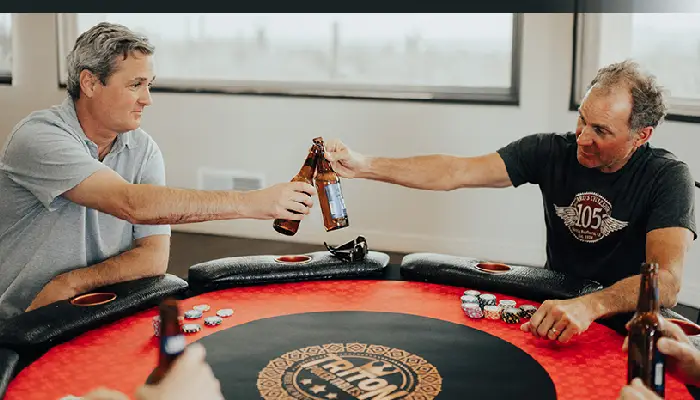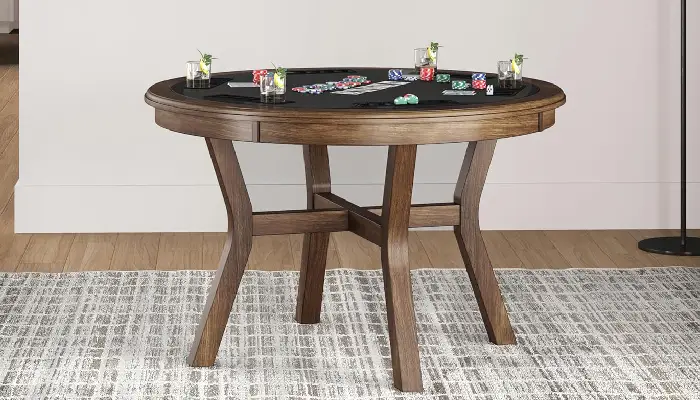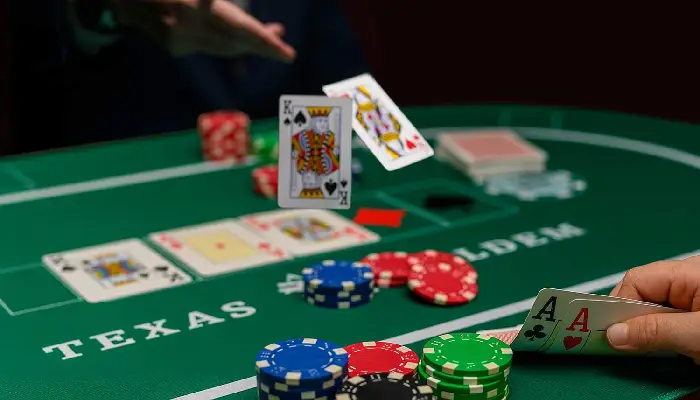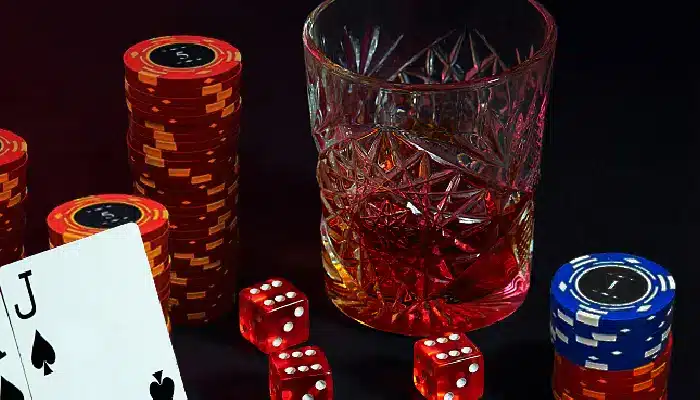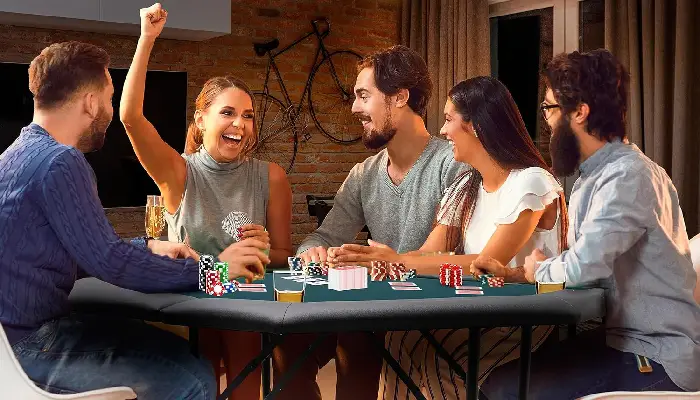Welcome to the exciting world of poker tables! Poker, a captivating game that blends skill, strategy, and a hint of luck, is as much about the environment as it is about the cards. Whether you’re a seasoned player aiming to host a professional tournament, a casual enthusiast planning a fun game night, or simply looking to add a stylish piece to your game room, selecting the best poker table is crucial to enhancing your overall experience.
In this comprehensive guide, I take you into the world of poker tables, covering everything from the various types to the materials and features that set them apart. Each type of table caters to different needs and preferences, ensuring that whether your games are serious or just for fun, your poker table will be a centerpiece of entertainment and competition.
Last update on 2024-07-27 / Affiliate links / Images from Amazon Product Advertising API
A Guide to Choosing the Perfect Poker Table
Mastering the Game Room
There’s a wide variety of types to choose from, each catering to different needs, preferences, and settings. Here’s a look at the different types of poker tables available:
- Foldable Poker Tables: Ideal for casual players or those with limited space. These folding tables can be easily stored away when unused, making them perfect for occasional games or small living spaces.
- Professional Poker Tables: Designed for serious players and high-end game rooms. These tables are typically larger, with premium materials and features like built-in chip trays and cup holders. They offer a more authentic casino-like experience.
- Custom Poker Tables: For those who want a personalized touch, custom poker tables are the way to go. You can customize everything from the size, shape, and surface material and even add unique features like LED lighting or custom graphics.
- Portable Poker Table Tops: These are designed to be placed on top of existing tables, offering a temporary and space-saving solution. Poker table tops are perfect for players who enjoy the flexibility of moving their game around or for those who don’t have space for a full-sized table.
- Oval Poker Tables: The most common shape for poker tables, resembling those found in casinos. These are suitable for larger groups of players and often come with all the standard features of a professional table.
- Round Poker Tables: These tables are great for smaller groups and promote a more social atmosphere. They are also more space-efficient, fitting well in smaller rooms.
- Octagonal Poker Tables: These have a unique shape that can add an aesthetic appeal to your game room. They typically seat up to 8 players and can be a good choice for both casual and serious games.
- Bar-Style Poker Tables: These are taller tables, often paired with bar stools. They’re great for a more casual, social game setting and are commonly found in home game rooms or man caves.
- Casino-Style Poker Tables: Designed to replicate the experience of playing in a real casino, these tables are often equipped with high-quality felt, padding, and accessories like chip trays and dealer slots.
- Convertible Poker Tables: These tables serve a dual purpose – they can be used as a dining table and then transformed into a poker table. Convertible poker tables are perfect for those who want a multifunctional piece of furniture.
Each type of poker table offers a unique experience and suits different playing styles and environments. Whether you’re looking for something casual for home use or a more professional setup, there’s a poker table type to meet your needs.
Last update on 2024-07-27 / Affiliate links / Images from Amazon Product Advertising API
From Felt to Frame
The Art of Crafting Premium Poker Tables
The materials used in the construction of a poker table significantly impact its durability, appearance, and overall playing experience. Here are some of the common materials used in poker table construction:
- Tabletop Surface Materials:
- Felt: The most traditional and common material used for the playing surface. High-quality felt provides a smooth, consistent surface that allows cards to slide easily.
- Speed Cloth: A popular choice for professional tables, speed cloth is a water-resistant and stain-resistant material that offers a smoother and faster surface than standard felt.
- Table Frame and Base Materials:
- Wood: Wooden frames are classic and sturdy, often used in high-end and custom tables. Different types of wood can be used, ranging from economical options like pine to luxurious choices like oak or mahogany.
- Metal: Metal frames offer a modern look and are known for their strength and durability. They can be designed to be foldable for easy storage.
- Padding Materials:
- Foam: Foam padding is used beneath the tabletop surface for comfort during play. Higher-density foam provides better resistance to wear and maintains its shape over time.
- Rail Materials:
- Vinyl or Leather: The rails, where players rest their arms, are usually padded and covered with vinyl or leather for comfort and a premium feel. Leather is more durable but also more expensive.
- Leg Materials:
- Wooden Legs: Often found on high-quality and custom tables, wooden legs offer stability and aesthetic appeal.
- Metal Legs: Used for their strength and the ability to fold on portable and foldable tables. They can be designed in various styles to match different table designs.
- Additional Features and Accessories:
- Cup Holders: Usually made of plastic or metal, embedded in the table or the rails.
- Chip Trays: Often made of plastic or metal, these trays are built into the table surface for convenience.
- Customization Options:
- LED Lighting: Added for aesthetic appeal, especially in custom tables.
- Custom Graphics: Printed on the felt or speed cloth for personalization.
The choice of materials depends on the intended use, budget, and personal preference. High-quality materials not only improve the look and feel of the table but also contribute to its longevity and the overall enjoyment of the game.
Poker Paradise
Unveiling the Elite Features of Modern Poker Tables
In the world of poker gaming, the features of a poker table play a pivotal role in enhancing the playing experience. From professional casinos to the cozy corners of a home game room, the modern poker table comes equipped with a variety of features designed for convenience, comfort, and style. Here’s a rundown of some key features that transform these tables from mere furniture to an integral part of the poker experience:
- Built-In Chip Trays: A staple in professional and high-end home tables, these trays keep chips organized and easily accessible, adding a touch of casino authenticity to your game.
- Cup Holders: Essential for preventing spills, cup holders are often built into the table’s armrest or side, allowing players to keep their drinks handy without risking damage to the table’s surface.
- Padded Armrests: Comfort is key in long poker sessions. Padded armrests, usually covered in high-quality vinyl or leather, provide a soft cushion for players’ arms, enhancing overall comfort.
- Dealer Slot and Chip Rack: In tables designed for professional play or serious home games, a designated dealer area complete with a chip rack makes dealing and chip distribution more efficient.
- Foldable Legs: For portable or foldable poker tables, sturdy, foldable legs are a must for easy storage and transportation, making them ideal for occasional players or those with limited space.
- Customizable Felts and Layouts: Custom poker tables often offer personalized felts and layouts, allowing owners to imprint logos, designs, or specific themes, adding a personal touch to the table.
- Recessed Playing Area: A slightly lower playing area compared to the armrests can help keep cards and chips secure on the table, providing a more professional gameplay experience.
- Electronic Systems: In ultra-modern tables, electronic systems for card shuffling, chip counting, or even lighting effects can be incorporated to enhance the tech aspect of the game.
- Adjustable Height: Some tables come with adjustable height features, making them versatile for different playing environments or player preferences.
- Convertible Tops: Convertible poker tables serve a dual purpose; they can be transformed into dining tables or other forms of gaming tables, making them a practical choice for multipurpose rooms.
These features, ranging from the basic necessities to the luxurious additions, are what make modern poker tables more than just a piece of furniture. They create an atmosphere, add to the convenience, and enhance the overall poker-playing experience, whether you are hosting a casual game night or a more formal poker tournament.
Last update on 2024-07-27 / Affiliate links / Images from Amazon Product Advertising API
Winning the Deal
Your Ultimate Guide to Buying the Perfect Poker Table
Purchasing a poker table can be as strategic and exciting as the game of poker itself. Whether setting up a home game room, outfitting a professional gaming space, or simply looking for a portable option for occasional play, understanding the key considerations when buying a poker table is crucial. This guide will take you through the various factors to consider, ensuring that you make an informed decision that suits your needs, budget, and style.
1. Identify Your Needs:
- Usage Frequency: Are you a casual player or a frequent host of poker nights? Your usage frequency will determine the durability and quality you should look for.
- Space Constraints: Measure the space where you plan to place the table. This will help you decide the size and shape of the best table for your room.
2. Types of Tables:
- From foldable and portable options to professional and custom-made tables, understand the types available and what each offers.
3. Material and Quality:
- Assess the materials used in construction. Look for sturdy frames, high-quality felt, and comfortable armrests. A good quality table will last longer and provide a better playing experience.
4. Features:
- Consider the features you want: chip trays, cup holders, padded armrests, foldable legs, etc. These features can significantly enhance your poker experience.
5. Budget:
Poker tables can range from affordable to high-end luxury models. Set a budget that reflects your commitment to the game and stick to it.
- Online vs. In-Store Shopping: Online shopping offers convenience and a more comprehensive selection, but in-store shopping allows you to see and feel the table. Decide which shopping experience suits you best.
- Reviews and Recommendations: Look for customer reviews and ask for recommendations from other poker players. Reviews can provide insights into the durability and practicality of different models.
6. Brand Reputation:
- Consider purchasing from reputable brands known for their quality and customer service.
7. Warranty and Return Policy:
- Check for warranties and return policies. A good warranty can provide peace of mind, ensuring that you’re covered in case of defects.
8. Delivery and Assembly:
- Think about the logistics of delivery and assembly, especially for larger tables. Some companies offer in-home assembly, which can be a convenient option.
Remember, a poker table is an investment in your gaming experience. Researching and choosing the right table will pay off countless hours of enjoyment and memorable game nights. Whether you opt for a simple foldable table for casual play or invest in a luxurious custom design, ensure that your choice aligns with your playing habits, space, and aesthetic preferences.
With the right poker table, you’re not just buying a piece of furniture; you’re setting the stage for countless thrilling poker showdowns and fostering a love for the game in a comfortable and inviting environment.
Last update on 2024-07-27 / Affiliate links / Images from Amazon Product Advertising API
Keeping the Game Sharp
Essential Tips for Poker Table Maintenance
Maintaining your poker table is crucial to preserve its quality and extend its lifespan, ensuring that every game is as enjoyable as the first. Proper care and maintenance keep the table looking great and protect your investment. Here are key maintenance tips to keep your poker table in top condition:
1. Regular Cleaning:
- Surface Cleaning: Regularly clean the felt or speed cloth surface to remove dust and dirt. Use a soft brush or a hand-held vacuum cleaner for gentle cleaning.
- Spill Management: In case of spills, immediately blot the area with a dry, absorbent cloth. Avoid rubbing, as it can push the liquid deeper into the felt.
2. Protective Measures:
- Use a Table Cover: When not in use, cover your poker table with a fitted cover to protect it from dust and accidental spills.
- Avoid Direct Sunlight: Prolonged exposure to sunlight can fade the felt and weaken the wood. Position your table away from direct sunlight.
3. Handling Chips and Cards:
- Be mindful when handling chips and cards. Rough handling can damage the surface of the table, especially when chips are dropped or thrown.
4. Regular Inspection:
- Periodically inspect your table for any signs of wear and tear, especially in areas like the armrests, legs, and the felt surface.
5. Repairing Damages:
- Felt Replacement: If the felt becomes too worn or damaged, consider replacing it. This can be a DIY project or done professionally.
- Fixing Loose Components: Tighten any loose screws or bolts, especially in foldable tables, to ensure stability.
6. Proper Storage:
- Choose a clean, dry area if you need to store your table. For foldable tables, ensure they are securely closed to avoid any accidental damage.
7. Professional Maintenance:
- For high-end tables, consider professional maintenance services for deep cleaning or repairs, ensuring your table stays in pristine condition.
8. Avoid Harsh Chemicals:
- Steer clear of harsh cleaning agents that can damage the felt or the wood finish. Use mild, poker table-specific cleaners or a slightly damp cloth for cleaning.
By following these maintenance tips, you can ensure your poker table remains a centerpiece of entertainment and enjoyment for years to come. Regular care keeps the table functional and preserves its aesthetic appeal, making every poker night an impressive and inviting experience.
Last update on 2024-07-27 / Affiliate links / Images from Amazon Product Advertising API
Building the Deck
A DIY Guide to Crafting Your Own Poker Table
Embarking on the journey of building your own poker table can be a fulfilling project for any poker enthusiast. It’s an opportunity to create a custom piece that perfectly suits your style, space, and gaming needs. This DIY guide will walk you through the basic steps and considerations to construct your personalized poker table, turning your vision into a reality.
1. Planning and Design:
- Decide the Size and Shape: Determine the dimensions of your table. Popular shapes include oval, round, and octagonal.
- Sketch Your Design: Create a detailed sketch of your table, including the playing surface, rail, and base. Consider the number of players and the available space in your room.
2. Materials and Tools:
- Selecting Materials: You’ll need sturdy wood for the base (like plywood), foam padding for comfort, felt or speed cloth for the surface, and vinyl for the rail.
- Gathering Tools: Essential tools include a saw, drill, staple gun, and upholstery tools.
3. Building the Tabletop:
- Cut the Wood: Cut the plywood to your desired shape for the tabletop.
- Apply Foam Padding: Attach foam padding to the playing surface for comfort and to reduce noise.
- Cover with Felt: Stretch the felt or speed cloth over the foam and staple it securely underneath.
4. Constructing the Rail:
- Build the Rail Frame: Cut and assemble the wood for the rail.
- Pad and Upholster the Rail: Attach foam padding and cover it with vinyl, stapling it securely in place.
5. Assembling the Base:
- Design the Base: The base needs to be sturdy and stable. Decide if you want it to be foldable for storage.
- Construct the Base: Build the base according to your design, ensuring it securely supports the tabletop.
6. Final Touches:
- Install Cup Holders: Add cup holders to the rail for convenience if desired.
- Decorative Elements: Add any decorative elements like custom logos, LED lights, or a unique finish to the wood.
7. Safety and Durability:
- Check for Stability: Ensure the table is stable and the surface is even.
- Smooth Edges: Sand any rough edges for safety and comfort.
Building your own poker table can be a challenging yet rewarding DIY project. Not only does it allow for customization, but it also adds a personal touch to your poker games. With some basic carpentry skills, patience, and creativity, you can create a unique poker table that will be the envy of your poker buddies and a cherished piece in your game room for years to come.
Last update on 2024-07-26 / Affiliate links / Images from Amazon Product Advertising API
Ace High Aesthetics
Designing Your Poker Table for Style and Function
The decor and style of a poker table can significantly enhance the ambiance of your gaming area, whether it’s a dedicated game room or a multipurpose space. A well-designed poker table serves as a functional piece for playing the game and a statement piece that reflects your style and the tone of your poker gatherings. Here’s how to blend style and functionality in your poker table design:
1. Choosing a Style:
- Modern: Sleek, with clean lines and minimalistic features. It often incorporates metal frames and contemporary materials.
- Traditional: Classic and elegant, usually featuring rich wood finishes, intricate craftsmanship, and a timeless appeal.
- Custom: Tailored to your personal tastes and needs, from unique shapes to themed designs, custom tables allow for complete creative freedom.
2. Color Scheme and Finish:
- Neutral Tones: Ideal for a sophisticated and understated look. They blend well in most room decors.
- Bold Colors: Perfect for adding a vibrant touch or highlighting a specific theme.
- Wood Finishes: Choose from a variety of wood finishes (like oak, cherry, or mahogany) for a warm, classic feel.
3. Table Surface:
- Felt Color: Traditional green is a classic choice, but you can opt for other colors to match your room’s decor or personal preference.
- Patterned or Custom-Printed Felt: Incorporate patterns or custom prints for a unique touch.
4. Lighting:
- Overhead Lighting: A well-designed overhead lamp can focus light directly on the table, enhancing visibility and creating a focal point.
- LED Accents: Use LED strips under the rails or around the table for a modern, edgy look.
5. Seating:
- Match chairs or bar stools to the table’s style. Ensure they are comfortable for long gaming sessions.
- Consider chairs with adjustable heights and casters for versatility.
6. Accessories and Art:
- Wall Art: Complement your table with poker-themed art or vintage casino posters.
- Decorative Items: Add decorative elements like card-themed decor, chips display, or a stylish card shuffler.
7. Multifunctionality:
- For multipurpose spaces, consider convertible poker tables that can double as dining or other gaming tables.
8. Personal Touch:
- Add personal touches such as engraved nameplates, family crests, or logos to give your table a unique identity.
The decor and style of your poker table can transform your gaming experience, making it more enjoyable and immersive. By carefully selecting the design elements that resonate with your personal taste and the overall aesthetic of your space, you can create a poker table that’s not just a place to play cards but a centerpiece of your home entertainment.
Last update on 2024-07-27 / Affiliate links / Images from Amazon Product Advertising API
Dealing the Right Spot
Maximizing Poker Table Usage for Every Setting
The usage of a poker table extends far beyond just dealing cards; it’s about creating an environment conducive to the game, whether in a casual home setting, a bustling casino, or during intense tournament play. Understanding how to optimize your poker table for its intended use is key to enhancing the overall experience for everyone involved. This guide explores the various settings in which poker tables are used and offers insights on how to maximize their potential in each scenario.
1. Home Poker Tables:
- Casual vs. Serious Play: Determine if the table will be used for casual family games or serious poker nights with friends. This influences the size and features of the table.
- Space Considerations: In a home environment, consider the space available. Foldable or convertible tables can be ideal for smaller spaces.
- Style and Decor: The table should complement the home’s decor, especially if it’s placed in a multi-purpose room or a central area like the living room.
2. Casino Poker Tables:
- Professional Standards: Casino tables are designed for high durability and constant use. They often feature high-quality materials and are equipped with premium features like chip trays and card shufflers.
- Player Capacity: Casinos typically opt for larger tables to accommodate more players, increasing the game’s efficiency and the casino’s profitability.
- Security Features: Casino tables may include special features like cameras or RFID technology for security and monitoring purposes.
3. Tournament Poker Tables:
- Spacious and Comfortable: Tournaments often involve long hours of play, necessitating spacious and comfortable tables.
- Broadcast Capabilities: Tables used in televised tournaments might include built-in cameras or spaces for microphones and other broadcasting equipment.
- Sponsorship and Branding: Tournament tables often feature spaces for logos and branding, important for sponsorship deals and event marketing.
- Regulation Compliance: Ensure the table meets specific tournament regulations regarding size, layout, and features.
4. Portable Poker Tables for Events:
- Easy Setup and Mobility: Ideal for event planners or those who host occasional poker nights at different venues. Portable tables should be easy to set up, dismantle, and transport.
- Durability for Frequent Movement: These tables should still be durable enough to withstand regular movement and usage despite their portability.
5. Multi-Game Poker Tables:
- Versatility: Some poker tables are designed to be multi-functional, allowing conversion for other games like blackjack or roulette, making them perfect for game rooms with limited space.
- Interchangeable Tops: Look for tables with interchangeable tops or inserts for easy switching between games.
6. Outdoor Poker Tables:
- Weather-Resistant Materials: For outdoor use, ensure the table is made with weather-resistant materials to withstand elements like sun and moisture.
- Sturdy Design: Outdoor tables should be sturdy enough to remain stable in varying outdoor conditions.
The poker table plays a central role in defining the game’s character and atmosphere in each of these settings. From the cozy corners of a home game room to the spotlight of a tournament stage, choosing and utilizing the right poker table can significantly impact the enjoyment and success of the game. By understanding the specific needs and nuances of each setting, you can select a poker table that not only meets but enhances your poker-playing experience.
Last update on 2024-07-27 / Affiliate links / Images from Amazon Product Advertising API
Finding the Perfect Fit
A Guide to Poker Table Size and Seating Capacity
Choosing the right size for a poker table is crucial, as it impacts the players’ comfort and overall gameplay experience. The size of the table determines how many players can be accommodated and influences the table’s placement and usability in a given space. This guide will explore the various aspects of poker table size and seating capacity to help you make an informed decision that suits your needs.
Standard Dimensions:
- Oval Tables:
- It is commonly used in casinos and tournaments.
- Typical sizes range from 84 to 96 inches in length.
- It comfortably accommodates 8 to 10 players.
- Round Tables:
- Ideal for smaller groups and more intimate games.
- Usually 48 to 60 inches in diameter.
- Typically seat 4 to 6 players.
- Octagonal Tables:
- Provide a distinct style and more personal space for each player.
- Generally 48 to 60 inches across.
- Seat up to 8 players.
Seating Capacity:
- Space Per Player: Each player should have at least 20 to 22 inches of space at the table. This ensures comfort and enough room to handle chips and cards.
- Dealer Space: If you have a dedicated dealer, ensure there is adequate space for them, especially in oval and octagonal tables.
Considerations for Home Use:
- Room Size: Ensure the table fits comfortably in your room, allowing space for players to move around and for chairs.
- Foldable or Extendable Options: For multipurpose or smaller rooms, consider a table with foldable or extendable features to save space when not in use.
Customization:
- Custom Sizes: Consider a custom-built table if standard sizes don’t suit your needs. This allows you to specify the exact dimensions and seating capacity.
- Additional Features: Think about adding cup holders, chip trays, or a convertible top for multifunctionality.
Practical Tips:
- Test Before Buying: If possible, test the table with chairs and ensure it fits your space and seating needs.
- Adjustable Chairs: Pair your table with adjustable chairs to accommodate players of different heights and preferences, enhancing comfort over long gaming sessions.
- Accessibility: Consider the accessibility around the table. There should be enough room for players to enter and exit their seats comfortably without disrupting the game.
By carefully considering your poker table’s size and seating capacity, you can ensure that it fits well within your designated space and provides a comfortable and enjoyable gaming experience for all players. Whether you’re hosting casual games at home or setting up a professional gaming environment, the right table size and seating arrangement can significantly enhance the atmosphere and functionality of your poker sessions.
Last update on 2024-07-27 / Affiliate links / Images from Amazon Product Advertising API
Raising the Stakes
Concluding Thoughts on Your Ultimate Poker Table Guide
As we reach the end of our journey through the world of poker tables, it’s clear that the right table can significantly enhance the poker-playing experience. From the casual games held in the comfort of your home to the high-stakes tournaments of professional settings, the choice of poker table impacts not just the game but also the ambiance and the enjoyment of the players.
Whether you’re drawn to the practicality of foldable and portable tables, the elegance of custom-designed pieces, or the professional feel of casino-style tables, your choice should reflect your personal style, needs, and the atmosphere you wish to create. The table’s materials, features, and size are not just functional aspects but also elements that contribute to the overall aesthetic and experience of the game.
Remember, a poker table is more than just a piece of furniture; it’s a centerpiece for social interaction, strategy, and fun. It’s a place where memories are made, friends and family gather, and, in some cases, legends are born! Choosing the right table sets the stage for countless nights of enjoyment and a lifetime of stories.
In your quest for the perfect poker table, consider the insights and tips provided in this guide. Whether you opt for a DIY project, a store-bought masterpiece, or a blend of both, your poker table can be a reflection of your love for the game and a symbol of your dedication to hosting the perfect poker night.
As the cards are dealt and the chips are stacked, let your poker table be the foundation of many thrilling games to come. Here’s to raising the stakes and creating unforgettable poker experiences around your ideal table!
Royal Flush Essentials
Essential Poker Table Accessories for the Ultimate Game Night
As you gather around your exquisite poker table, ready for a night of strategy and fun, consider enhancing your game with some cool accessories. Imagine the satisfying clink of high-quality poker chips as they stack up in the heat of the game. These chips, a symbol of your progress and prowess, add a tangible thrill to each bet and call. Choosing a set of chips that compliments your table can also add a touch of class and cohesion to your gaming setup.
But what’s a poker game without the seamless flow of cards? An automatic card shuffler is more than just a convenience; it’s a nod to efficiency and fairness, ensuring a thoroughly mixed deck and smooth gameplay. Whether you’re dealing out a round of Texas Hold’em or enjoying other card games, this gadget keeps the action moving without pause. Meanwhile, a well-placed dealing shoe becomes essential to the table, organizing the game and adding an authentic casino feel. These add-ons keep your cards in pristine condition and add a professional touch.
Lastly, let’s not forget the practicality and elegance of a card holder for those lengthy games, ensuring comfort and reducing hand fatigue. This simple addition speaks volumes about your attention to detail and care for your guests’ comfort.
Incorporating these accessories – poker chips, an automatic card shuffler, a card tray, a dealing shoe, and a card holder – into your poker nights isn’t just about functionality. It’s about creating an immersive, seamless experience that mirrors the excitement and sophistication of a real casino right in the comfort of your home.
